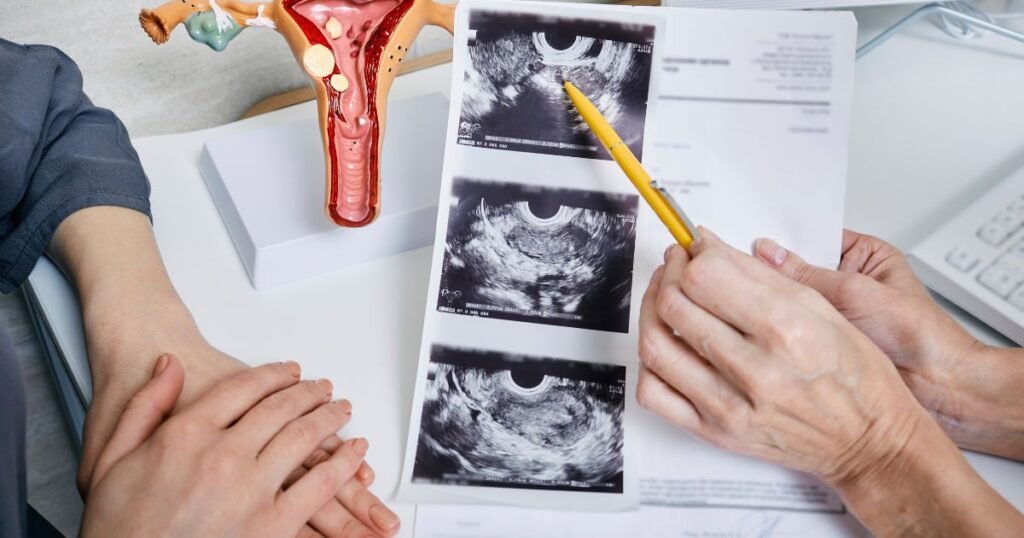Introduction
The uterus is one of the most important organs of the female reproductive system. Its position and shape can have a significant impact on a woman’s overall health, especially when it comes to fertility. One of the most common variations in the position of the uterus is an anteverted uterus, which means that the uterus is tilted forward towards the bladder. While an anteverted uterus is considered normal, many women may experience painful intercourse, urinary incontinence, and difficulty in conceiving. Suppose you have been diagnosed with an anteverted uterus. In that case, it’s important to understand this condition’s causes, symptoms, and potential complications.
Read More: knowledgeglaxy.com
What is Anteverted Uterus?
Before delving into the details, it is crucial to understand what it means. The anteverted uterus is a term used to describe the positioning and orientation of the uterus within the female pelvis. In simple terms, it refers to the forward tilt of the uterus towards the bladder. This positioning is known as an anteverted uterus.
This anatomical variation is considered to be the most common and occurs naturally in many women. The uterus is usually positioned in an anteverted manner, which means it is tilted forward rather than in a straight vertical position.
How common is it?
It’s important to note that having an anteverted uterus is incredibly common and considered a normal variation of uterine positioning. Approximately 70 to 90 percent of women have an anteverted uterus. It is the most typical position for the uterus and does not typically cause any health concerns or complications.
Factors which can contribute for the Anteverted Uterus
Several factors contribute to the anteverted position of the uterus. Firstly, it can be attributed to genetics and the natural development of the reproductive organs. Additionally, hormonal changes during puberty and pregnancy can also impact the positioning of the uterus.
It is important to note that having an anteverted uterus is not a cause for concern or a medical condition. It is considered to be a normal anatomical variation. However, in some cases, an excessively tilted uterus or other underlying conditions may cause symptoms or complications that require medical attention.
Understanding the anteverted uterus and its normal position within the female pelvis is essential for women to be better aware of their reproductive health.
Position of Uterus in the Female Body
The position of the uterus is determined by the ligaments and muscles that support it within the pelvis. These structures help maintain the uterus in its proper place. The anteverted position cannot be changed or altered through lifestyle choices or medical interventions.

It’s worth mentioning that an anteverted uterus differs from other uterine positions, such as a retroverted uterus (tilted backward) or a retroflexed uterus (bent back). Although less common, these variations are also considered normal and do not cause any issues.
While it is generally not a cause for concern, it’s important to remember that every woman’s body is unique, and variations in uterine position can exist. Suppose you have any problems about your uterine position or experience symptoms that are causing discomfort. Consulting with a healthcare professional for proper evaluation and guidance is always recommended in that case.
An anteverted uterus, a tilted one, is a common anatomical variation in women. While most women have a uterus that is positioned in a straight vertical position, an anteverted uterus is tilted forward towards the bladder. This unique positioning occurs due to the way the uterus develops during fetal growth.
Several factors can contribute to the development of an anteverted uterus.
Genetics: One of the most common causes is genetics. If your mother or other female relatives have a tilted uterus, there is a higher chance that you may also have one. Hormonal imbalances during puberty or pregnancy can also lead to the formation of an anteverted uterus.
Pelvic Adhesion or Scar Tissue: In some cases, pelvic adhesions or scar tissue can cause the uterus to become tilted. This can occur due to previous surgeries, such as a C-section or pelvic inflammatory disease (PID). Additionally, certain conditions such as endometriosis or fibroids can also impact the position of the uterus, leading to an anteverted uterus.
Harmonal Imbalances: Hormonal imbalances might also play an imortant role in causing an anteverted uterus. Fluctuations in hormone levels, such as those experienced during pregnancy or menopause, can affect the positioning of the uterus.
In most cases, having an anteverted uterus is not considered a medical condition or a cause for concern. It is estimated that around 75% of women have a tilted uterus. However, in rare instances, a highly tilted uterus may cause discomfort or contribute to difficulties in conceiving. Suppose you are experiencing severe symptoms or fertility concerns related to your anteverted uterus. In that case, consulting with a healthcare professional for a thorough evaluation is recommended.
Symptoms and signs
An anteverted uterus, or tipped uterus, is a common anatomical variation affecting many women. While it doesn’t typically cause health issues, understanding the symptoms and signs associated with an anteverted uterus can help women better understand their bodies.

Pelvic Pain
Pelvic pain is one of the primary symptoms of an anteverted uterus. Its intensity varies from mild discomfort to more severe cramping sensations. Some women may experience this pain during menstruation, sexual intercourse, or everyday activities. So there might be other causative factors for the pelvic pain, so it’s always better to consult a healthcare professional for a thorough evaluation.
Increased Urinary Frequency
Another common symptom is increased urinary frequency. Women with an anteverted uterus may need to urinate more frequently than usual. This can be attributed to the position of the uterus pressing against the bladder, causing a sensation of needing to empty the bladder more often.
Menstrual Cramps
Menstrual cramps may be more intense for some women with an anteverted uterus, as the uterus may be positioned in a way that puts more pressure on the pelvic region.
Difficulties Durring Sexual Intercourse
In some cases, an anteverted uterus can also lead to difficulties during sexual intercourse. This can include discomfort or pain during penetration, which may be related to the position of the uterus. Communication with a partner and exploring different positions or techniques can help alleviate any discomfort or pain experienced during intimacy.
It’s important to remember that the symptoms and signs of an anteverted uterus can vary from woman to woman. Some may not experience any symptoms, while others may have more pronounced symptoms.
Diagnosis and medical tests for an Anteverted Uterus
Diagnosing typically involves complete physical check, combination of medical history, and imaging tests. If you are experiencing symptoms such as pelvic pain or difficulties durring the sexual intercourse, In that case, consulting with a healthcare professional for an accurate diagnosis is important.
Physcial Examination: During a physical examination, your healthcare provider will use their hands to feel the position and shape of your uterus. They may also perform a pelvic exam to assess any abnormalities or changes in the pelvic area. These initial assessments can provide valuable insights into the positioning of the uterus.
Transvginal Ultrasound: In certain cases, imaging tests may be recommended to confirm the diagnosis. One common imaging technique is transvaginal ultrasound. This involves the insertion of a small probe into the vagina, which emits sound waves to create images of the pelvic organs. Transvaginal ultrasound can accurately determine the position and tilt of the uterus, helping to diagnose an anteverted uterus.

Computed tomography (CT) scan or Magentic Resonance Imaging (MRI) may be utilized in more complex cases or to rule out other potential causes of symptoms. These tests provide detailed images of the pelvic region, allowing healthcare professionals to assess the structure and position of the uterus more comprehensively.
It is essential to remember that the diagnosis of an anteverted uterus should be made by a qualified healthcare professional. They will interpret the results of medical tests and consider other factors such as symptoms, medical history, and individual circumstances to provide an accurate diagnosis. Seeking medical advice and following through with recommended tests is crucial for understanding and managing an anteverted uterus effectively.
Can an anteverted uterus affect fertility?
Many women may wonder if having an anteverted uterus can impact their fertility. It is essential to understand that the position of the uterus itself does not directly affect fertility. An anteverted uterus is simply a natural variation in the positioning of the uterus within the pelvis.
However, in some cases, it may be associated with other underlying conditions that can affect fertility. For example, if the uterus is tilted too far forward, it may create difficulty for sperm to reach the cervix. This can potentially hinder the chances of conception.
Additionally, certain medical conditions such as endometriosis or pelvic inflammatory disease (PID) can cause the uterus to become anteverted. These conditions can lead to complications that may impact fertility, such as scarring or blockages in the fallopian tubes.

It’s important to note that having an anteverted uterus alone does not necessarily mean that fertility will be compromised. Many women with this anatomical variation conceive without any issues. However, if you have been trying to conceive for an extended period without success, the it would be better to consult with a healthcare professional to rule out any underlying conditions that could be affecting fertility.
Treatment options for the Anteverted Uterus
If you have been diagnosed with an anteverted uterus, it is important to understand the available treatment options. The treatment approach will depend on your condition’s specific symptoms and underlying causes. Here are some standard treatment options that you and your healthcare provider may consider:
- Observation and monitoring: In many cases, it does not require any treatment. If you are not experiencing any symptoms or complications, your healthcare provider may recommend regular check-ups to monitor the condition and ensure there are no changes or complications over time.
- Pelvic Floor Excercises: Strengthening your pelvic floor muscles can help improve the position and stability of your uterus. Activities such as Kegels can be beneficial in providing support to the uterus and reducing discomfort or pain associated with an anteverted uterus.
- Hormonal therapy: If hormonal imbalances are contributing to your condition, your healthcare provider may prescribe hormonal treatment. This can help regulate your menstrual cycle and correct any structural abnormalities causing the anteverted uterus.
- Surgical intervention: In severe cases, where non surgical treatment options are not enough to provide relief from pain, then surgery is recommended. Surgical procedures such as uterine suspension or uterine repositioning can be performed to correct the position of the uterus and alleviate symptoms.
- Pain management: If you are experiencing pain or discomfort, your healthcare provider may recommend pain management techniques. This can include over-the-counter pain relievers, prescription medications, or alternative therapies such as acupuncture or physical therapy.

Lifestyle tips for managing an Anteverted Uterus
Managing an anteverted uterus is a topic of concern for many women. While the condition does not typically cause significant health issues, it’s important to understand how lifestyle choices can play a role in managing this condition and ensuring overall well-being.
Healthy Weight: It’s vital to keep a healthy weight in the first place. Weight gain can increase strain on the uterus and may make any pain or symptoms brought on by this problem worse. Regular exercise, including walking, swimming, or yoga, can help in weight management and promote pelvic muscle strength and flexibility.
Proper Posture: Another important aspect to consider is proper posture. Many women with it may experience lower back pain or discomfort. Maintaining good posture while sitting and standing can alleviate strain on the back and provide relief. Using ergonomic chairs and pillows for support can also be beneficial.
Sexual Intercourse Position: It’s worth noting that certain sexual positions may be more comfortable than others for women with an anteverted uterus. Experimenting with different situations and communicating with your partner can help determine what works best for you and minimizes any potential discomfort during intimacy.
Proper Hygiene: In terms of menstrual health, using sanitary products that are comfortable and non-irritating is essential. Opting for pads or tampons made from organic materials can reduce the risk of irritation and inflammation. Additionally, practicing proper hygiene and regularly changing sanitary products can help prevent infections and maintain optimal vaginal health.
Managing Stress Levels: Lastly, managing stress levels is crucial for overall well-being. Stress can exacerbate any discomfort associated with it and may contribute to hormonal imbalances. Engaging in stress-reducing activities such as meditation, deep breathing exercises, or engaging in hobbies and activities that bring joy and relaxation can help in managing stress levels.
While these lifestyle tips may not directly impact the position of the uterus, they can certainly contribute to a better quality of life for women with an anteverted uterus.
Complications and risks associated with an Anteverted Uterus
While an anteverted uterus is a common anatomical variation, it is important to understand that it may be associated with certain complications and risks. While most women with an anteverted uterus have no issues, there are a few considerations to keep in mind.
One potential complication is difficulty during gynecological procedures such as pelvic exams or intrauterine device (IUD) insertion. Due to the position of the uterus, these procedures may be more challenging and uncomfortable for some women with an anteverted uterus. However, it is important to note that healthcare professionals are trained to handle such situations and can provide appropriate guidance and support.
Urinary Tract Infections (UTIs)
Another potential concern is the increased risk of urinary tract infections (UTIs). The angle of an anteverted uterus can put pressure on the bladder, potentially leading to incomplete emptying of the bladder or difficulty in entirely voiding urine. This stagnant urine can create a favorable environment for bacterial growth, increasing the risk of UTIs. Maintaining good hygiene practices and promptly addressing any signs or symptoms of UTIs can help mitigate this risk.

Fertility Issues
In rare cases, an anteverted uterus may contribute to fertility issues. This is more likely if the uterus is severely tilted or additional underlying factors affect fertility. It is important to consult with a healthcare provider if you are experiencing difficulties conceiving or have concerns about your reproductive health.
It is crucial to remember that having an anteverted uterus does not automatically mean experiencing complications or risks. Many women with this anatomical variation lead perfectly healthy lives without issues related to their uterus position. Regular check-ups with a healthcare professional, maintaining overall reproductive health, and addressing any concerns promptly can help ensure a healthy and comfortable experience for those with an anteverted uterus.
Conclusion and key takeaways
In conclusion, understanding the anteverted uterus is crucial for women who may have been diagnosed with it or want to learn more about it. While an anteverted uterus is considered a normal anatomical variation, it can sometimes be associated with specific symptoms or conditions.
The key takeaways from this article are:
- An anteverted uterus is a common position of the uterus where it tilts forward towards the bladder.
- It is not a medical condition or a cause for concern in most cases.
- Some women with an anteverted uterus may experience symptoms such as pelvic pain or discomfort during sexual intercourse.
- An anteverted uterus does not affect fertility or the ability to conceive.
- In rare cases, an anteverted uterus may be associated with conditions like endometriosis or adenomyosis, which may require medical intervention.
- Regular gynecological check-ups and discussions with your healthcare provider are important to monitor any changes or symptoms related to your uterus.
We hope you found our blog post on understanding the anteverted uterus informative and helpful. It is essential to have a comprehensive understanding of our bodies and any unique conditions we may have. By exploring the causes, symptoms, and more of an anteverted uterus, we aim to empower individuals with the knowledge they need to make informed decisions about their health.
Is an anteverted uterus a common condition?
Yes, having an anteverted uterus is quite common. It’s estimated that around 80% of women have this anatomical variation.
Can an anteverted uterus cause fertility problems?
In most cases, having an anteverted uterus does not affect fertility. However, in some rare instances where the tilt is severe or accompanied by other conditions such as endometriosis or fibroids, it may contribute to difficulties getting pregnant.
Does an anteverted uterus require treatment?
Typically, no treatment is necessary for an anteverted uterus as it is considered a normal anatomical variation. However, if symptoms such as pain during intercourse or menstrual cramps become severe and impact your quality of life, medical intervention may be recommended.
Can pregnancy complications occur with an anteverted uterus?
Having an anteverted uterus does not increase the risk of pregnancy complications. The position of the uterus usually adjusts naturally during pregnancy to accommodate fetal growth and development.
Can exercise worsen symptoms associated with an anteverted uterus?
Moderate exercise is generally safe and beneficial for women with an anteverted uterus. However, it’s always a good idea to consult your healthcare provider before starting any new exercise regimen to ensure it suits your needs and circumstances.






